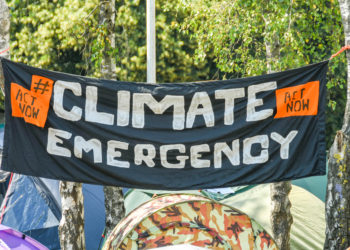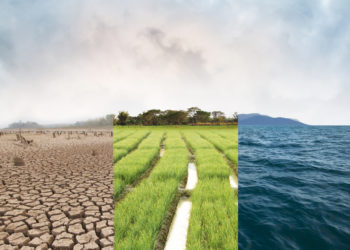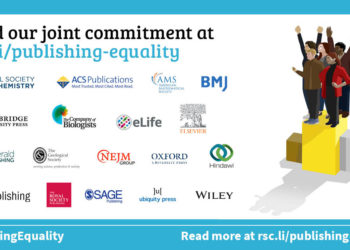Editor’s Note: Today’s post is by Thea Sherer. Thea is the Director of Group Communications for Springer Nature. She is responsible for the Springer Nature Group’s sustainability strategies and reporting, working closely with both the global responsible business steering group and the company’s environment committee.
2020 was gearing up to be a crucial year for the planet, with the next Conference of the Parties (COP26) due to review progress against the country-level emission reduction targets set by the Paris Agreement, and the UN to declare a ‘decade of action’ to focus global attention on the need for more urgent progress on the sustainable development goals (SDGs).
But on January 30th 2020, the World Health Organization declared a public health emergency of international concern, and the world’s attention shifted from climate to a different crisis. Due to the global pandemic, conferences were postponed, plans were scaled back and the day-to-day work of millions of researchers in all fields had to adapt to a new reality almost overnight.
For those of us in the scholarly communications field, the parallels between these two global crises — of COVID and climate — is obvious. The combined efforts of globally dispersed networks of researchers to understand emerging and uncertain science, build collaborative new approaches, influence policymakers to act and prioritize the needs of the most vulnerable, and the need to counter disinformation at every turn.
As publishers of research, we all know that we have an important role in disseminating the evidence base that has the power to determine solutions and drive better decision making at the policy level. Playing a part in this mechanism is what motivates many of us to work in this sector.
If the world is to meet the stretching targets of the Paris Agreement, the evidence tells us that collective action is needed. Employees, regulators, investors and customers expect and even demand that we take responsibility for the impacts our sector has and to reduce the environmental footprint of our operations, and of the products and services we create. As Haseeb Irfanullah outlined in his Scholarly Kitchen post last week, our sector must also consider its impacts and play its part.

What action can we all take now?
In October last year, the UN and the International Publishers Association launched the SDG Publishers Compact, an industry-wide initiative of publishers to contribute to the UN’s Decade of Action, which is a movement to help ensure that the sustainable development goals are delivered by their current deadline of 2030. Outreach and collaborations like this compact is a clear recognition that our industry has a particular responsibility to act — both to inform and inspire action amongst others through the content it publishes, and to take direct action by developing sustainable practices within our own operations.
With appropriate collaboration and concerted collective action, we can together make a material difference in tackling climate change and other societal challenges, like those represented in the SDGs.
Learning by doing
One way in which we can all hold ourselves to account is through the process of measuring, managing, and reporting on our environmental impacts. At Springer Nature (full disclosure: my employer), we have long felt it important to do this, to ensure that we remain active and adaptive to the changes that we need to make as a company — and as an industry — to contribute to a more environmentally sustainable future. By baselining and measuring, we have learned how we can reduce the environmental impacts of our operations and play a part in responding to the expectations that many have of us, given that our stable of publications includes many related to climate and sustainability.
We know that many others in the industry are doing the same and recognize the importance of this baselining to understand where changes can be made.
Lessons Learned
What have we learned from four years of regular data collection and reporting on environmental sustainability, and where do we think the industry should focus now?
Senior-level engagement is, of course, vital. At Springer Nature we have built sustainability into our Group strategy and have created an executive-level steering board that oversees activity with key metrics that are reported regularly. Global operational committees generate the priority action plans, and one of these is focused solely on environmental impacts. The executive sponsor for the environment committee is our Chief Operating Officer.
As an office-based company, we found that our operational carbon footprint was relatively low, with business flights making up a large component of emissions. We learned early on that we could make a difference by sourcing more of our energy from renewable sources. We now purchase green electricity, either directly through the supplier or indirectly using renewable energy certificates, for around 140 sites across 38 countries. Understanding the sourcing of paper used in our products was another early priority as was removing, where possible, plastic wrapping from books and journals.
As a large global company with operations in more than 50 countries, collating environmental data is an extensive, and often tricky exercise. Having announced in 2020 our intention to become carbon neutral, we invited auditors to review data related to the company’s carbon footprint. This led us to being able to confirm that we are now carbon neutral for emissions related to offices, fleet, and flights.
Our previous work in understanding the key levers for the business’s carbon footprint meant we were aware of the steps we would need to take to achieve neutrality, and we knew that while reductions would be possible, there will remain a reliance on carbon offsetting to compensate for outstanding emissions. Here we made good use of internal expertise, forming a working group involving climate and sustainability experts from our editorial teams to advise on additional, verifiable projects to work with.
We have been energized in our actions by the commitment that many of our colleagues have to supporting the business in lessening its environmental impact. As well as formal working groups focusing on specific issues such as the paper policy or electricity purchasing, a ‘green office network’ of more than 120 volunteers from 14 countries raise awareness and generate ideas on smaller changes that can add up to make a difference at the local level. Despite COVID-19 related office closures over the past year, these networks have continued to connect and share advice on how to reduce personal carbon footprints during lockdowns.
Connecting and convening
While it is true that businesses from many sectors are engaging with the issue of climate change, the scholarly communications sector is unique in its place at the nexus of research and policy. Ensuring that the latest research is clearly communicated and makes its way to those who need it most is where we can play a direct role in effecting change. We also have a role to play in making clear connections between research in the physical and natural sciences, and the humanities and social sciences. As we have seen during the pandemic, only when policymakers consider these together can we create the best frameworks for action in the face of complex challenges.
This year, as plans for the delayed COP26 — due to take place in Glasgow in the UK in November — take shape, we have a collective responsibility to ensure that evidence-based, robust, and independent research is at the heart of the policy discussions.
The COVID experience has shown how important effective collaboration is in reducing vexing limits to knowledge and that the scholarly community is able respond as challenges arise. As Nature reported in December, more than 200,000 articles (dependent on search terms used) about the pandemic were published in 2020. The same impetus is true for other sustainability challenges, including climate change. According to data from the Dimensions database, there were more than 55,000 documents related to SDG13: Climate action, published in 2020, with double digit growth year-on-year, reflecting the level of interest and engagement from the research community.
The Climate Pledge
22nd April is Earth Day, intended to raise awareness and mobilize individuals and organizations in support of protection of the planet. Springer Nature has joined more than 100 organizations committed to be net-zero carbon by 2040 — a decade ahead of the Paris Agreement’s goal of 2050. Signatories of The Climate Pledge agree to measure and report greenhouse gas (GHG) emissions on a regular basis; implement decarbonization strategies; and neutralize remaining emissions through quality offsetting schemes. For Springer Nature, our next steps include understanding how we can embed the learnings we have taken from 2020 in our ‘new normal’ — for example with more virtual meetings, and less time in the air — given how significant a contribution to the company’s overall carbon footprint business travel has been.
We are fortunate to be part of a sector that so clearly has a positive contribution to make in addressing societal challenges, populated by people who are evidence-driven and solution-oriented. As the UN has already recognized, through our collective actions, we can make a meaningful difference.
Discussion
1 Thought on "Guest Post — Climate Action: Collaboration for Progress on Earth Day"
Thank you Thea, for superbly outlining how scholarly publishers can take forward practical, strong, and ambitious climate and sustainability actions. It would be interesting to hear from others how they are coming forward with their individual and collective initiatives in this regard.



